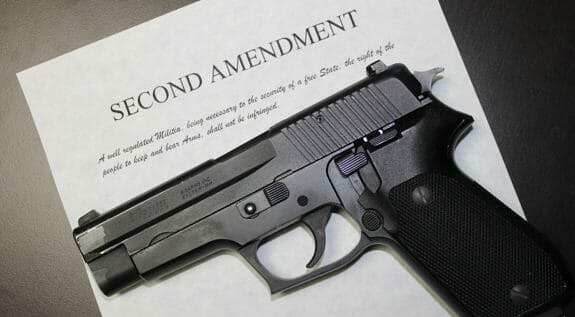

Topping Gun News In 2022: SCOTUS
Nullifies 'Good Cause' Restriction

June's Supreme Court ruling in the Bruen case has opened the
door to new legal challenges of restrictive 'gun control' laws.
By Dave Workman. Dec 26, 2022
Article Source
It was the biggest gun rights story of the year—probably the decade—and the reaction by the gun control lobby and its allies in state legislatures provided all the evidence necessary for Second Amendment advocates to argue this isn’t about safety, but about control and treating a fundamental right as though it is a government-regulated privilege.
New York State Rifle & Pistol Association v. Bruen is the Supreme Court decision—authored by Associate Justice Clarence Thomas for a 6-3 majority—sent anti-gun lawmakers into a scramble, not just in New York, but in a half-dozen other states. In the aftermath, there was no acknowledgement that a century-old law had wronged generations of Empire State gun owners, but an effort to write a law that many activists believe is worse than the one now stricken. It has drawn federal lawsuits already.
Democrat-controlled legislatures in New Jersey and California hurried to write new statutes which are already being challenged in the federal courts.
What the Bruen ruling said has broad implications, and it clearly put lower federal courts on notice.
“In Heller and McDonald,” Justice Thomas wrote for the majority, “we held that the Second and Fourteenth Amendments protect an individual right to keep and bear arms for self-defense. In doing so, we held unconstitutional two laws that prohibited the possession and use of handguns in the home. In the years since, the Courts of Appeals have coalesced around a ‘two-step’ framework for analyzing Second Amendment challenges that combines history with means-end scrutiny.
“Today, we decline to adopt that two-part approach,” he continued. “In keeping with Heller, we hold that when the Second Amendment’s plain text covers an individual’s conduct, the Constitution presumptively protects that conduct. To justify its regulation, the government may not simply posit that the regulation promotes an important interest. Rather, the government must demonstrate that the regulation is consistent with this Nation’s historical tradition of firearm regulation.”
Henceforth, no lower court can use this “balancing” effort to virtually always decide for the state, thus treating the right to keep and bear arms differently from other protected individual rights.
As Justice Thomas concluded his opinion, he noted for the court, “The constitutional right to bear arms in public for self-defense is not ‘a second-class right, subject to an entirely different body of rules than the other Bill of Rights guarantees.’…We know of no other constitutional right that an individual may exercise only after demonstrating to government officers some special need. That is not how the First Amendment works when it comes to unpopular speech or the free exercise of religion. It is not how the Sixth Amendment works when it comes to a defendant’s right to confront the witnesses against him. And it is not how the Second Amendment works when it comes to public carry for self-defense. New York’s proper-cause requirement violates the Fourteenth Amendment in that it prevents law-abiding citizens with ordinary self-defense needs from exercising their right to keep and bear arms.”
The Bruen ruling did not expand Second Amendment rights, but rather restored them in states with restrictive carry laws. That lawmakers in these states have labored to get around the Bruen standard demonstrates—at least to those in the gun rights community—this fight over Second Amendment rights is not about public safety but about disarming law-abiding citizens and discouraging them from exercising a right enshrined in the Bill of Rights.
Bruen not only has resulted in a blitz of lawsuits against new state concealed carry laws, but also provided a platform upon which previous lawsuits may be re-energized.
Important among these is a case in Maryland known as Bianchi v. Frosh. This is a challenge to Maryland’s ban on so-called “assault weapons” involving the Second Amendment Foundation (SAF), the Citizens Committee for the Right to Keep and Bear Arms and others. It was granted certiorari by the high court a week after the Bruen ruling was handed down. The high court then vacated the lower court ruling upholding the ban and remanded the case back to the 4th Circuit for further consideration under the guidelines set down in Bruen.
The ruling may also play a pivotal role in the outcome of federal lawsuits challenging bans on so-called “high-capacity magazines” in California, Washington and elsewhere, plus the language in Oregon’s Measure 114, which is being challenged by four separate federal lawsuits, two of them filed by SAF.
Another case, challenging the “assault weapons” ban in Delaware, might also play into this scenario.
What the Bruen ruling did not do is put to rest the battle over Second Amendment rights. If anything, it provided the legal ammunition for rights organizations including SAF, CCRKBA, NRA, Gun Owners of America and the National Shooting Sports Foundation, to challenge more restrictive gun laws.
From all indications, 2023 is going to be an active, if not volatile, year in state legislatures and the courts.
![]()

























